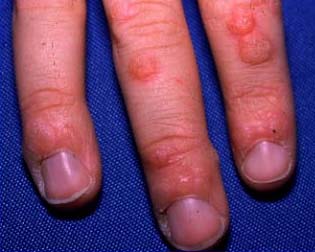November 4th, 2009 by Paul Auerbach, M.D. in Better Health Network, Health Tips
No Comments »

This is the third post based upon my presentation given at the Wilderness Medical Society Annual Meeting held in Snowmass, Colorado from July 24-29, 2009. The presentation was entitled “Just When You Thought It Was Safe to Go Back in the Water.”” The topic was an overview of hazardous marine animals and it was delivered by me. In the previous post, there was information about stingrays and scorpionfishes. In this post, there is information about injuries from sea urchins incurred in the marine environment.
Sea urchins are free-living echinoderms with egg-shaped, globular or flattened bodies. They are covered by tightly arranged spines and/or triple-jawed pedicellariae, which are seizing and envenoming organs. The spines can be brittle, hollow, sharp and venom-bearing or blunt and non venom-bearing (such as with Hawaiian pencil urchins). Most persons are envenomed when they step upon or brush against an urchin. Read more »
This post, What To Do If You Step On A Sea Urchin, was originally published on
Healthine.com by Paul Auerbach, M.D..
October 24th, 2009 by Paul Auerbach, M.D. in Better Health Network, Health Tips
No Comments »

 This is the next post based upon my presentation given at the Wilderness Medical Society Annual Meeting held in Snowmass, Colorado from July 24-29, 2009. The presentation was entitled “Just When You Thought It Was Safe to Go Back in the Water.”” The topic was an overview of hazardous marine animals and it was delivered by me. In the previous post, there was information about shark attacks. In this post, there is information about envenomations incurred in the marine environment.
This is the next post based upon my presentation given at the Wilderness Medical Society Annual Meeting held in Snowmass, Colorado from July 24-29, 2009. The presentation was entitled “Just When You Thought It Was Safe to Go Back in the Water.”” The topic was an overview of hazardous marine animals and it was delivered by me. In the previous post, there was information about shark attacks. In this post, there is information about envenomations incurred in the marine environment.
Marine venoms, similar to other toxins and poisons that originate in the animal and plant kingdoms, may cause a wide range of human physiological derangements. It is very important to remember that certain of these venoms, such as that elaborated by jellyfish, may invoke a serious allergic reaction.
Stingrays are a commonly incriminated group of envenoming animals. There are more than 10 species found in U.S. coastal waters, with from 1 to 4 venomous “stings” found on the top of the caudal appendage (“tail’). The spine is a serrated cartilaginous structure that houses venom glands covered by a fragile tissue sheath. Thus, when the spine enters a human victim, most commonly on the lower limb (ray is stepped upon) or upper limb (ray is handled), the tissue sheath is disrupted and venom enters the wound. Thus the injury is just a puncture/cut and an envenomation. Read more »
This post, How To Treat Stingray Envenomation, was originally published on
Healthine.com by Paul Auerbach, M.D..
October 11th, 2009 by Bongi in Better Health Network, True Stories
No Comments »

 I recently read a post that reminded me of an incident. depending on which side of the eyelid you found yourself that day, it could have been funny…or not.
I recently read a post that reminded me of an incident. depending on which side of the eyelid you found yourself that day, it could have been funny…or not.
I was doing casualty sessions after hours. It was a way of making ends meet while I was specialising, but mostly I just hated it. Anyway one night, between the snotty noses and neurotic parents a patient actually came in with a casualty-worthy complaint. He had a small laceration on his forehead. We decided to glue it together with dermabond because it was so small. I decided to leave it to the sister. After all the unit was full to overflowing with snotty noses and paranoid parents that I was required to work through and get rid of.
After a while the sister came to me. She had terror written all over her face. Read more »
*This blog post was originally published at other things amanzi*
October 8th, 2009 by RamonaBatesMD in Better Health Network
No Comments »

I want to share this section of the old textbook, A Text-Book of Minor Surgery by Edward Milton Foote, MD (1908) mainly because I want to share the photo of the “angular knife for incision of the tympanic membrane” with you.
Otitis Media
This is a common disease of childhood, usually following a cold in the head. The prominent symptom is earache. Every physician ought to be able to recognize the bulging outward of the membranum tympani and to relieve the pressure by incision of the membrane at the most favorable situation – viz., the inferior and posterior portion. The introduction of warm olive oil into the external meatus will sometimes relieve pain, and the application of external heat may also be tried; but the pain of a severe earache, unless relieved by puncture of the membrane, usually demands the internal administration of morphine. Read more »
*This blog post was originally published at Suture for a Living*
September 16th, 2009 by RamonaBatesMD in Better Health Network, Health Tips
No Comments »

I’m sure I don’t see as many patients with common skin warts as my family practice or dermatology colleagues, but these patients still make it to my office. Sometimes it’s the primary complaint, sometimes it’s an afterthought. In reviewing the topic, it occurred to me that most patients don’t need to see any of us for this problem. They mostly need to accept the fact that the treatment takes TIME. So if you will persist, then you will often be successful without the expense of seeing a doctor. (photo credit)
Common warts (Verruca vulgaris) are caused by the human papillomavirus (HPV). Warts on the hands or feet do not carry the same clinical consequences of HPV infection in the genital area. It is estimated about 10% of children and adolescents have warts at any given time. As many as 22% of children will contract warts during childhood.
Common warts can occur anywhere on the body, but 70% occur on the hand. Often they will disappear on their own within a year. Even with treatment, warts can take up to a year to go away.
Before heading to the doctor, there are treatments you can try at home: salicylic acid or duct tape.
When using the 17% salicylic acid gel (one brand name: Compound W), it must be applied every day until the wart is gone. Only apply to the wart, not the skin around the wart. This treatment is enhanced by covering the wart with an occlusive water-proof band-aid or duct tape after applying the acid. It can also be enhanced by gently filing the wart with an emery board daily to remove the dead cells prior to applying the salicylic acid. Treatment can take weeks to months. Don’t give up early.
Duct Tape can take weeks or months to be effective. Apply the duct tape to the wart and keep it in place for six days. After removing the tape, soak the wart, and pare it down with a filing (emery) board. Repeat the above until the wart disappears. Once again, don’t give up early.
The two treatments (salicylic acid and duct tape) can be combined. Apply the salicylic acid liquid to the wart before bedtime. After letting it air dry for a minute or so, then apply the duct tape over the wart, completely covering the area. Remove the duct tape the following morning. Each time you remove the tape, you will be debriding some of the wart tissue. Repeat the application each night, until there is no remaining wart tissue. As with using only one treatment, don’t give up early.
If the above don’t work or you just don’t want to take the time, then you may wish to see your physician for removal. He can use cryotherapy to destroy the wart. This method may involve repeated treatment over several weeks. You can do the following to “get the wart ready for removal” and make the cryotherapy more effective:
-
Every night for 2 weeks, clean the wart with soap and water and put 17% salicylic acid gel (one brand name: Compound W) on it.
-
After putting on the gel, cover the wart with a piece of 40% salicylic acid pad (one brand name: Mediplast). Cut the pad so that it is a little bit bigger than the wart. The pad has a sticky backing that will help it stay on the wart.
-
Leave the pad on the wart for 24 hours. If the area becomes very sore or red, stop using the gel and pad and call your doctor’s office.
-
After you take the pad off, clean the area with soap and water, put more gel on the wart and put on another pad. If you are very active during the day and the pad moves off the wart, you can leave the area uncovered during the day and only wear the pad at night.
If none of the above work, then your wart may need to be removed surgically. Remember the above all take time, so give them time to work. Even if the wart disappears with any of the above treatments, it may recur later.
Sources
Treatment of Warts; Medscape Article, May 27, 2005: W. Steven Pray, PhD, DPh; Joshua J. Pray, PharmD
What Can Be Done About a Hand Wart That Keeps Reappearing After Removal?; Medscape Article, May 31, 2007; Richard S. Ferri, PhD, ANP, ACRN, FAAN
Duct tape and moleskin equally effective in treating common warts; Medscape Article 2007; Barclay L.
Duct Tape More Effective than Cryotherapy for Warts; AAFP, Feb 1, 2003; Karl E. Miller, M.D.
*This blog post was originally published at Suture for a Living*
















